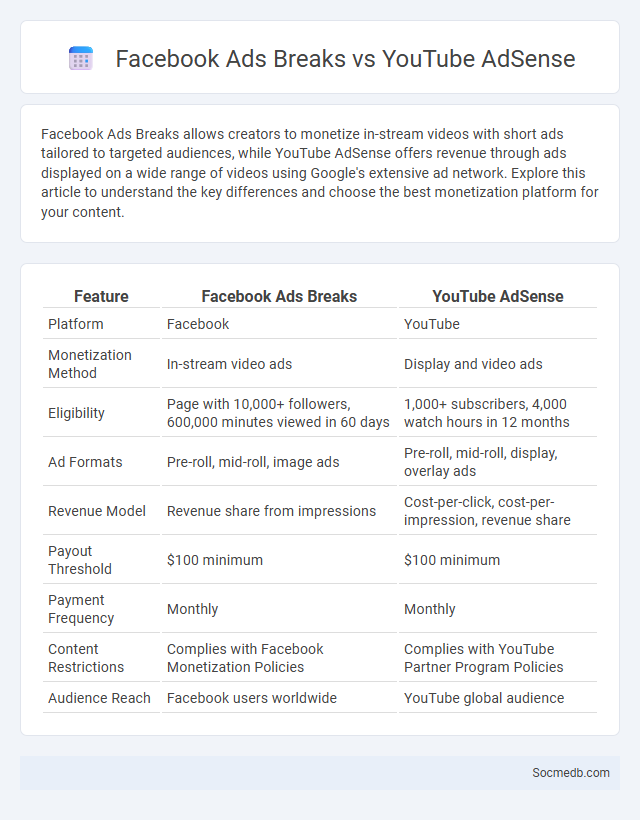
Photo illustration: Facebook Ads Breaks vs YouTube AdSense
Facebook Ads Breaks allows creators to monetize in-stream videos with short ads tailored to targeted audiences, while YouTube AdSense offers revenue through ads displayed on a wide range of videos using Google's extensive ad network. Explore this article to understand the key differences and choose the best monetization platform for your content.
Table of Comparison
| Feature | Facebook Ads Breaks | YouTube AdSense |
|---|---|---|
| Platform | YouTube | |
| Monetization Method | In-stream video ads | Display and video ads |
| Eligibility | Page with 10,000+ followers, 600,000 minutes viewed in 60 days | 1,000+ subscribers, 4,000 watch hours in 12 months |
| Ad Formats | Pre-roll, mid-roll, image ads | Pre-roll, mid-roll, display, overlay ads |
| Revenue Model | Revenue share from impressions | Cost-per-click, cost-per-impression, revenue share |
| Payout Threshold | $100 minimum | $100 minimum |
| Payment Frequency | Monthly | Monthly |
| Content Restrictions | Complies with Facebook Monetization Policies | Complies with YouTube Partner Program Policies |
| Audience Reach | Facebook users worldwide | YouTube global audience |
Overview of Facebook Ads Breaks, YouTube AdSense, and Digital Monetization
Facebook Ads Breaks enable content creators to monetize videos by inserting short ads during natural breaks, maximizing viewer retention and revenue potential. YouTube AdSense offers a robust platform where video creators earn through targeted ads based on viewer demographics and engagement metrics. Digital monetization strategies, including these platforms, leverage data-driven advertising to convert content views into consistent income streams, optimizing earnings across social media ecosystems.
Eligibility Requirements for Facebook Ads Breaks vs YouTube AdSense
Facebook Ads Breaks require creators to have at least 10,000 followers and 600,000 total minutes viewed in the last 60 days, with videos at least three minutes long to qualify for monetization. YouTube AdSense eligibility demands a minimum of 1,000 subscribers and 4,000 watch hours within the past 12 months, along with adherence to community guidelines and monetization policies. Your ability to monetize content on these platforms depends heavily on meeting these specific follower counts and engagement thresholds.
Revenue Models: Comparing Facebook and YouTube Payout Structures
Facebook primarily generates revenue through targeted advertising, offering ad placements in news feeds and stories with user engagement metrics driving advertiser investments. YouTube monetizes content via ad revenue sharing, where creators receive a percentage typically around 55% of ad earnings, incentivizing high views and watch time. Both platforms utilize subscription services--Facebook with Facebook Gaming and YouTube with YouTube Premium--to diversify revenue streams and enhance creator payouts.
Content Guidelines and Restrictions for Monetization
Social media platforms enforce strict content guidelines and restrictions to qualify for monetization, including prohibitions on hate speech, violence, adult content, misinformation, and copyright violations. Creators must adhere to community standards such as YouTube's Ad-Friendly Content Guidelines or Facebook's Monetization Eligibility Standards to maintain revenue streams. Violations can result in demonetization, content removal, or account suspension, emphasizing the importance of compliant, advertiser-friendly content.
Audience Reach and Engagement Potential on Both Platforms
Maximizing audience reach on social media platforms like Facebook and Instagram requires leveraging their unique algorithms and user demographics. Facebook offers extensive targeting options with over 2.9 billion active users, leading to higher potential reach for diverse content, while Instagram excels in engagement with visually-driven posts and Stories, boasting over 2 billion active monthly users. Your strategy should focus on Facebook's broad audience diversity and Instagram's high engagement rates to optimize visibility and interaction on both platforms.
Ad Formats: Facebook Ads Breaks vs YouTube AdSense Options
Facebook Ads Breaks offer in-stream video ads that seamlessly integrate into content, targeting users based on demographic, interest, and behavior data, which enhances engagement for advertisers. YouTube AdSense provides various ad formats including skippable and non-skippable video ads, bumper ads, and overlay ads, allowing creators to monetize content through tailored viewer experiences and maximizing revenue potential. Both platforms utilize advanced targeting algorithms and analytics to optimize ad performance and deliver high ROI for marketers.
Monetization Tools and Analytics for Creators
Social media platforms offer advanced monetization tools such as ad revenue sharing, fan subscriptions, and branded content partnerships that enable creators to generate consistent income. Comprehensive analytics dashboards provide deep insights into audience demographics, engagement rates, and content performance, allowing creators to optimize their strategies effectively. Leveraging these monetization features alongside data-driven analytics helps creators maximize revenue potential and grow their online presence sustainably.
CPM and RPM Rates Comparison: Facebook vs YouTube
Facebook typically offers CPM (Cost Per Mille) rates ranging from $5 to $12, with RPM (Revenue Per Mille) rates averaging around $2 to $5 depending on audience engagement and ad formats. YouTube's CPM rates vary widely, often between $6 and $15, while RPM rates usually fall between $3 and $7, influenced by video content type and viewer demographics. Comparing both platforms, YouTube generally yields higher RPM rates due to its video-centric format optimizing ad impressions and viewer watch time, though Facebook's extensive targeting capabilities can drive competitive CPM pricing.
Pros and Cons of Facebook Ads Breaks and YouTube AdSense
Facebook Ads Breaks offer targeted video monetization with robust audience analytics, enabling creators to generate revenue during video content efficiently. However, they require compliance with specific eligibility criteria and can limit ad frequency, potentially affecting overall earnings. YouTube AdSense provides a vast global reach with diverse ad formats, enhancing income through both display and video ads but often faces fluctuating CPM rates and strict content monetization policies that may delay revenue stream growth.
Choosing the Best Monetization Platform for Your Content
Selecting the best monetization platform for your content hinges on understanding your audience demographics and content type, whether it's video, blogs, or podcasts. Platforms like YouTube, Patreon, and TikTok offer varied revenue streams including ad revenue, subscriptions, and direct fan support. Maximizing earnings requires aligning platform algorithms and monetization features with your engagement metrics and growth strategy.
 socmedb.com
socmedb.com